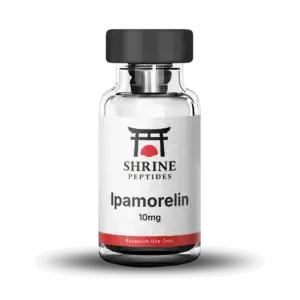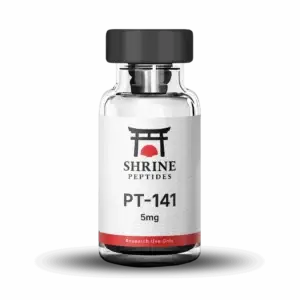Sermorelin (10mg)
$92.00
Sermorelin (10mg) – Research grade peptide for laboratory investigations and preclinical studies | Research Use Only – Not for Human Consumption
Sermorelin (10mg) Research Compound
Research Use Only – Not for Human or Animal Consumption
Sermorelin (10mg) is a synthetic research peptide that has been investigated in laboratory settings for its potential interactions with various biological pathways. This research compound has been studied in preclinical models to evaluate its pharmacological properties and potential mechanisms of action.1 Preliminary investigations have examined this peptide’s effects on cellular signaling pathways, receptor interactions, and physiological responses in controlled laboratory environments.
Research Overview
Laboratory studies have explored the potential biological activities of Sermorelin (10mg) through various experimental methodologies. Research has focused on characterizing the peptide’s structure-activity relationships, binding affinities to target receptors, and downstream signaling cascade activation.2 Preclinical investigations have utilized multiple research models to assess the compound’s pharmacokinetic properties, including absorption, distribution, metabolism, and elimination characteristics. These fundamental research efforts contribute to the broader understanding of peptide-based signaling mechanisms and their potential applications in biological research.
Preclinical Investigations
Research teams have conducted systematic investigations to evaluate Sermorelin (10mg)’s biological activities in controlled experimental settings. Studies have employed various in vitro and in vivo methodologies to assess the peptide’s effects on cellular processes, tissue function, and systemic responses in research models.3 Data from these investigations have contributed to understanding the peptide’s potential mechanisms of action, optimal dosing parameters for research applications, and potential interactions with biological systems.
Product Specifications
- Contents: Sermorelin (10mg)
- Form: Lyophilized powder
- Purity: >98% (verified by HPLC)
- Storage: Store at -20°C in a dry environment
- Reconstitution: Use bacteriostatic water for laboratory applications
- Stability: Stable when stored properly under recommended conditions
Quality Assurance and Documentation
- Third-party laboratory tested for purity and identity verification
- Certificate of Analysis (COA) available upon request for each batch
- HPLC chromatography results provided
- Mass spectrometry data available
- Manufactured under strict quality control protocols
- Batch-specific documentation and traceability
- Compliance with research-grade standards
Research Applications
- Peptide receptor interaction studies
- Cellular signaling pathway research
- Pharmacokinetic and pharmacodynamic investigations
- Structure-activity relationship studies
- Preclinical model research
- Biochemical pathway mapping
- Molecular mechanism elucidation
- In vitro biological activity screening
- Peptide stability and formulation research
- Comparative peptide pharmacology studies
Important Research Notice
FOR LABORATORY AND RESEARCH USE ONLY. This product is intended exclusively for scientific research, in vitro studies, and laboratory investigations. This compound is not intended for human or animal consumption, clinical applications, or any diagnostic or therapeutic uses.
Researchers should consult relevant scientific literature and follow appropriate safety protocols when handling this research compound. Proper laboratory equipment, personal protective equipment, and training are required for working with this material.
Regulatory Compliance Statement
This product is sold as a research chemical for laboratory use only. Shrine Peptides operates as a chemical supplier. Shrine Peptides is not a compounding pharmacy or chemical compounding facility as defined under 503A of the Federal Food, Drug, and Cosmetic Act. Shrine Peptides is not an outsourcing facility as defined under 503B of the Federal Food, Drug, and Cosmetic Act.
The statements made within this product description have not been evaluated by the US Food and Drug Administration. The products we offer are not intended to diagnose, treat, cure or prevent any disease. Human/Animal Consumption Prohibited. Laboratory/In-Vitro Experimental Use Only.
Please review and adhere to our Terms and Conditions before ordering.
References:
- Garcia JM, Merriam GR, Kargi AY. Growth Hormone in Aging. [Updated 2019 Oct 7]. In: Feingold KR, Anawalt B, Boyce A, et al., editors. Endotext [Internet]. South Dartmouth (MA): MDText.com, Inc.; 2000. https://www.ncbi.nlm.nih.gov/books/NBK279163/?report=reader
- Prakash, A, and K L Goa. “Sermorelin: a review of its use in the diagnosis and treatment of children with idiopathic growth hormone deficiency.” BioDrugs : clinical immunotherapeutics, biopharmaceuticals and gene therapy vol. 12,2 (1999): 139-57. https://pubmed.ncbi.nlm.nih.gov/18031173/
- National Center for Biotechnology Information. “PubChem Compound Summary for CID 16129620, Sermorelin” PubChem
- Clark, R G, and I C Robinson. “Growth induced by pulsatile infusion of an amidated fragment of human growth hormone releasing factor in normal and GHRF-deficient rats.” Nature vol. 314,6008 (1985): 281-3. https://pubmed.ncbi.nlm.nih.gov/2858818/
- Drugs at FDA: FDA Approved Drugs. https://www.accessdata.fda.gov/scripts/cder/daf/index.cfm?event=overview.process&ApplNo=020443
- Junichi I. et al, Growth hormone secretagogues: history, mechanism of action, and clinical development, JSCM Rapid Communications Vol. 3 Issue 1, 09 February 2020. https://onlinelibrary.wiley.com/doi/full/10.1002/rco2.9
- Prakash, A, and K L Goa. “Sermorelin: a review of its use in the diagnosis and treatment of children with idiopathic growth hormone deficiency.” BioDrugs : clinical immunotherapeutics, biopharmaceuticals and gene therapy vol. 12,2 (1999): 139-57. https://pubmed.ncbi.nlm.nih.gov/18031173/
- Koutkia, Polyxeni et al. “Growth hormone-releasing hormone in HIV-infected men with lipodystrophy: a randomized controlled trial.” JAMA vol. 292,2 (2004): 210-8. https://pubmed.ncbi.nlm.nih.gov/15249570/
- Vitiello, Michael V et al. “Growth hormone releasing hormone improves the cognition of healthy older adults.” Neurobiology of aging vol. 27,2 (2006): 318-23. https://pubmed.ncbi.nlm.nih.gov/16399214/
- Chang, Yuanhao et al. “A potentially effective drug for patients with recurrent glioma: sermorelin.” Annals of translational medicine vol. 9,5 (2021): 406. doi:10.21037/atm-20-6561. https://www.ncbi.nlm.nih.gov/pmc/articles/PMC8033379/
- Sinha, Deepankar K et al. “Beyond the androgen receptor: the role of growth hormone secretagogues in the modern management of body composition in hypogonadal males.” Translational andrology and urology vol. 9,Suppl 2 (2020): S149-S159. doi:10.21037/tau.2019.11.30. https://www.ncbi.nlm.nih.gov/pmc/articles/PMC7108996/
- Zhou, F., Zhang, H., Cong, Z., Zhao, L. H., Zhou, Q., Mao, C., Cheng, X., Shen, D. D., Cai, X., Ma, C., Wang, Y., Dai, A., Zhou, Y., Sun, W., Zhao, F., Zhao, S., Jiang, H., Jiang, Y., Yang, D., Eric Xu, H., … Wang, M. W. (2020). Structural basis for activation of the growth hormone-releasing hormone receptor. Nature communications, 11(1), 5205. https://doi.org/10.1038/s41467-020-18945-0
- Vittone, J., Blackman, M. R., Busby-Whitehead, J., Tsiao, C., Stewart, K. J., Tobin, J., Stevens, T., Bellantoni, M. F., Rogers, M. A., Baumann, G., Roth, J., Harman, S. M., & Spencer, R. G. (1997). Effects of single nightly injections of growth hormone-releasing hormone (GHRH 1-29) in healthy elderly men. Metabolism: clinical and experimental, 46(1), 89–96. https://doi.org/10.1016/s0026-0495(97)90174-8
- Khorram, O., Laughlin, G. A., & Yen, S. S. (1997). Endocrine and metabolic effects of long-term administration of [Nle27]growth hormone-releasing hormone-(1-29)-NH2 in age-advanced men and women. The Journal of clinical endocrinology and metabolism, 82(5), 1472–1479. https://doi.org/10.1210/jcem.82.5.3943








Reviews
There are no reviews yet.